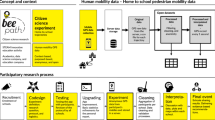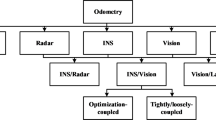Abstract
Global positioning system (GPS) technology is increasingly used to assess geographically varying exposure in population studies. However, there has been limited evaluation of accuracy and completeness of personal GPS data. The ability of a GPS data logger to assess location of children during usual activity was evaluated. Data collected for 4 days from 17 children wearing GPS loggers, recorded every 15 s, were evaluated for completeness by time of day during weekend and weekdays, and for accuracy during nighttime at home. Percentage of possible GPS-recorded points and of 5-min intervals with at least one recorded location were examined. Mean percentage of total possible 15-s interval locations recorded daily was less than 30%. Across participants, the GPS loggers recorded 1–47% of total possible location points on weekends and 1–55% on weekdays. More complete data were measured during travel to school (average 91%). The percentage of daily 5-min intervals with recorded data was as high as 53%. At least one location was recorded during 69% of 5-min intervals before school (0630–0800 h), 62% during school (0800–1400 h) and 56% after school (1400−1700 h). During night time (0000–0600 h), on average, location was recorded for less than 25% of 5-min intervals and accuracy was poor. The large proportion of missing data limits the usefulness of GPS logging instruments for population studies. They have potential utility for assessing on-road travel time and route. GPS technology has limitations, and lessons learned from this evaluation can be generalized to the use of GPS in other research settings.
This is a preview of subscription content, access via your institution
Access options
Subscribe to this journal
Receive 6 print issues and online access
$259.00 per year
only $43.17 per issue
Buy this article
- Purchase on SpringerLink
- Instant access to full article PDF
Prices may be subject to local taxes which are calculated during checkout











Similar content being viewed by others
References
Maddison R, Ni Mhurchu C . Global positioning system: a new opportunity in physical activity measurement. Int J Behav Nutr Phys Act 2009; 6: 73.
Grow HM, Saelens BE, Kerr J, Durant NH, Norman GJ, Sallis JF . Where are youth active? Roles of proximity, active transport, and built environment. Med Sci Sports Exerc 2008; 40 (12): 2071–2079.
Phillips ML, Hall TA, Esmen NA, Lynch R, Johnson DL . Use of global positioning system technology to track subject’s location during environmental exposure sampling. J Expo Anal Environ Epidemiol 2001; 11 (3): 207–215.
McKone TE, Ozkaynak H, Ryan PB . Exposure information in environmental health research: current opportunities and future directions for particulate matter, ozone, and toxic air pollutants. J Exp Sci Environ Epidemiol 2009; 19 (1): 30–44.
Elgethun K, Fenske RA, Yost MG, Palcisko GJ . Time-location analysis for exposure assessment studies of children using a novel global positioning system instrument. Environ Health Perspect 2003; 111 (1): 115–122.
Freeman NCG, Lioy PJ, Pellizzari EDO, Zelon H, Thomas K, Clayton A et al. Responses to the region 5 NHEXAS time/activity diary. J Expo Anal Environ Epidemiol 1999; 9 (5): 414–426.
Stone AA, Shiffman S . Capturing momentary, self-report data: a proposal for reporting guidelines. Ann Behav Med 2002; 24 (3): 236–243.
Elgethun K, Yost MG, Fitzpatrick CT, Nyerges TL, Fenske RA . Comparison of global positioning system (GPS) tracking and parent-report diaries to characterize children’s time-location patterns. J Expo Sci Environ Epidemiol 2007; 17 (2): 196–206.
Maddison R, Jiang Y, Vander Hoorn S, Exeter D, Mhurchu CN, Dorey E . Describing patterns of physical activity in adolescents using global positioning systems and accelerometry. Pediatr Exerc Sci 2010; 22 (3): 392–407.
Cooper AR, Page AS, Wheeler BW, Griew P, Davis L, Hillsdon M et al. Mapping the walk to school using accelerometry combined with a global positioning system. Am J Prev Med 2010; 38 (2): 178–183.
Nuckols JR, Ward MH, Jarup L . Using geographic information systems for exposure assessment in environmental epidemiology studies. Environ Health Perspect 2004; 112 (9): 1007–1015.
Duncan MJ, Badland HM, Mummery WK . Applying GPS to enhance understanding of transport-related physical activity. J Sci Med Sport 2009; 12 (5): 549–556.
Quigg R, Gray A, Reeder AI, Holt A, Waters DL . Using accelerometers and GPS units to identify the proportion of daily physical activity located in parks with playgrounds in New Zealand children. Prev Med 2010; 50 (5-6): 235–240.
Cooper AR, Page AS, Wheeler BW, Hillsdon M, Griew P, Jago R . Patterns of GPS measured time outdoors after school and objective physical activity in English children: the PEACH project. Int J Behav Nutr Phys Act 2010; 7: 31.
Adams C, Riggs P, Volckens J . Development of a method for personal, spatiotemporal exposure assessment. J Environ Monit 2009; 11 (7): 1331–1339.
Gerharz LE, Kruger A, Klemm O . Applying indoor and outdoor modeling techniques to estimate individual exposure to PM2.5 from personal GPS profiles and diaries: a pilot study. Sci Total Environ 2009; 407 (18): 5184–5193.
Wu J, Jiang C, Liu Z, Houston D, Jaimes G, McConnell R . Performances of different global positioning system devices for time-location tracking in air pollution epidemiological studies. Environ Health Insights 2010; 4: 93–108.
Tager I, Hammond SK, Balmes J, Mann J, Mortimer K, Neugebauer R et al. Fresno Asthmatic Children’s Environment Study (FACES). Final report prepared for the California Air Resources Board, Sacramento, CA. University of California, Berkeley, CA; Sonoma Technology, Inc., Petaluma, CA; California Air Resources Board, Sacramento, CA; and California Department of Health Services, Richmond, CA. Report No.: ARB Contract # 99-322 (STI-903370.07-2863) 2006.
Goldberg D . The USC WebGIS Geocoding Platform. GIS Res Lab Res Rep 2011; 11: http://spatial.usc.edu/wp-content/uploads/gislabtr11.pdf (accessed 28 February 2013).
Boscoe F . The science and art of geocoding. In: Rushton G, Armstrong MP, Gittler J, Greene BR, Pavlik CE, West MM, et al (eds. Geocoding Health Data: The Use of Geographic Codes in Cancer Prevention and Control, Research and Practice. CRC Press: Boca Raton. 2008, pp 95–109.
Donders AR, van der Heijden GJ, Stijnen T, Moons KG . Review: a gentle introduction to imputation of missing values. J Clin Epidemiol 2006; 59 (10): 1087–1091.
Hu S, Fruin S, Kozawa K, Mara S, Paulson SE, Winer AM . A wide area of air pollutant impact downwind of a freeway during pre-sunrise hours. Atmos Environ 2009; 43 (16): 2541–2549.
Ozkaynak H, Palma T, Touma JS, Thurman J . Modeling population exposures to outdoor sources of hazardous air pollutants. J Expos Sci Environ Epidemiol 2007; 18 (1): 45–58.
Zhu Y, Hinds WC, Kim S, Sioutas C . Concentration and size distribution of ultrafine particles near a major highway. J Air Waste Manag Assoc 2002; 52 (9): 1032–1042.
Zhou Y, Levy JI . Factors influencing the spatial extent of mobile source air pollution impacts: a meta-analysis. BMC Public Health 2007; 7: 89.
Behrentz E, Sabin LD, Winer AM, Fitz DR, Pankratz DV, Colome SD et al. Relative importance of school bus-related microenvironments to children's pollutant exposure. J Air Waste Manag Assoc 2005; 55 (10): 1418–1430.
Adams C, Riggs P, Volckens J . Development of a method for personal, spatiotemporal exposure assessment. J Environ Monitor 2009; 11 (7): 1331–1339.
Rainham D, Krewski D, McDowell I, Sawada M, Liekens B . Development of a wearable global positioning system for place and health research. Int J Health Geogr 2008; 7: 59.
Morabia A, Amstislavski PN, Mirer FE, Amstislavski TM, Eisl H, Wolff MS et al. Air pollution and activity during transportation by car, subway, and walking. Am J Prev Med 2009; 37 (1): 72–77.
Zandbergen PA . Accuracy of iPhone locations: a comparison of assisted GPS, WiFi and cellular positioning. Transact GIS 2009; 13: 5–25.
Zandbergen PA, Barbeau SJ . Positional accuracy of assisted GPS data from high-sensitivity GPS-enabled mobile phones. J Navig 2011; 64 (03): 381–399.
Acknowledgements
This study was supported by the NIEHS grant numbers 5P30ES007048, 5P01ES011627, 5P01ES009581 and 5R01 ES016535; the USEPA grant numbers R826708 and RD831861; and the Hastings Foundation.
Author information
Authors and Affiliations
Corresponding author
Ethics declarations
Competing interests
The authors declare no conflict of interest.
Rights and permissions
About this article
Cite this article
Dueker, D., Taher, M., Wilson, J. et al. Evaluating children’s location using a personal GPS logging instrument: limitations and lessons learned. J Expo Sci Environ Epidemiol 24, 244–252 (2014). https://doi.org/10.1038/jes.2013.11
Received:
Accepted:
Published:
Issue date:
DOI: https://doi.org/10.1038/jes.2013.11
Keywords
This article is cited by
-
Assessing and enhancing the utility of low-cost activity and location sensors for exposure studies
Environmental Monitoring and Assessment (2018)



